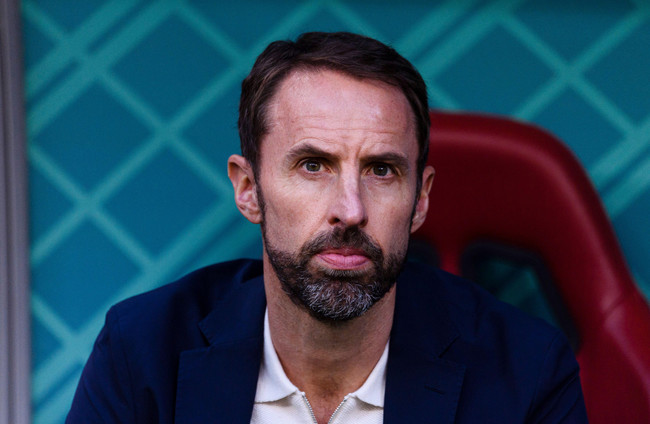IN INTERNATIONAL football, there is often an odd disconnect between the opinion of people from a particular country who follow that team and those who view events from the outside.
At the 2014 World Cup, Uruguay’s Luis Suarez was roundly condemned for biting Italy defender Giorgio Chiellini by virtually everyone apart from Uruguayan media, who defended their star player.
One of the pet peeves of Irish football fans during major tournaments is the perceived hyperbolic way in which the English media sometimes cover their team, epitomised by the “it’s coming home” mentality that frequently dominates the discourse.
Yet perhaps it has not occurred to many of those complainants how strange media coverage of the Irish team might seem to outside eyes.
For example, take what is widely seen as Ireland’s greatest achievement on the international stage — Italia ’90.
To most foreigners, Ireland getting to the quarter-finals of the World Cup would have been viewed in a similar manner to Saudi Arabia beating Argentina or Japan overcoming Germany at Qatar 2022.
Basically, an incredible achievement. An uncomplicated 10/10 from players, coaching staff, and all concerned.
And there was certainly plenty of euphoria at home as Jack Charlton’s Ireland qualified for a first-ever World Cup and hit unprecedented heights.
Yet was the joy and praise for the team unequivocal? No.
Outsiders might have been baffled to see Eamon Dunphy throwing his pen across an RTÉ studio in disgust as Ireland drew 0-0 against Egypt — a result that, in the end, helped them progress from their group.
But Dunphy was not the only one who had some reservations about Ireland’s style of play under Charlton. There were similar feelings among other football purists, including Stephen Kenny, who has said he stopped going to see Ireland play under the Englishman because of the unattractive style.
Yet to most people from England and beyond who watched Ireland play at Italia ’90 and indeed for much of the Charlton era, the question of the style of play would have barely registered — they simply would have seen a small country punching hugely above their weight and however they were doing it would have been assumed to be correct owing to the remarkable results generated.
There was a similar contrast in the Martin O’Neill era, particularly as it drew to a close.
There was a palpable frustration in large portions of the Irish media coverage and fanbase with the team’s somewhat Charlton-esque direct style that was arguably outdated by then, as well as on account of the perceived conservatism in many of the team selections.
The grumbling grew more audible as O’Neill’s approach led to diminishing returns — reaching the round of 16 at the Euros was followed up by a disappointing climax to the World Cup qualifying campaign amid a 5-1 hammering by Denmark in the play-offs.
But there was a noticeable chasm between how many of the Irish journalists and fans viewed the team and the perception of British media who covered O’Neill’s men to varying degrees.
There were basically two camps: those who believed Ireland should be playing a better brand of football even with somewhat limited players (closer to what Stephen Kenny is doing now) and those who felt O’Neill was more or less faultless and simply making the best of a bad situation.
After all, the former Celtic boss had overseen qualification to the Euros knockout stages with no obvious world-class stars in the team. What more could be expected? This certainly was the view of O’Neill himself if recent extracts of the manager’s autobiography are anything to go by.
The lively debate on BBC Radio Five Live between ex-Celtic player Chris Sutton and Ken Early of Second Captains perhaps is the aptest standalone example of these two differing assessments on O’Neill’s legacy with Ireland clashing.
Yet Irish journalists will conversely often see media expectations surrounding the English football team as unreasonably high.
The Gareth Southgate criticism that seems particularly vociferous at Qatar 2022 will be baffling to some.
The former Aston Villa defender is England’s most successful manager in decades.
He came very close to guiding the Three Lions to the World Cup final in Russia four years ago and was a penalty shootout away from triumphing at Euro 2020, having guided England to a first major final since 1966.
An outsider might naively presume that Southgate, on the back of those two considerable achievements, would be granted serious leeway with future decisions.
Yet in shades of Italia ’90 with Ireland, sections of the English media have been highly critical of Southgate and his team in recent months, and throughout his reign to an extent, primarily owing to the style of play.
One of the main narratives that have emerged is that Southgate is supposedly ‘afraid to take the handbrakes off’.
England, with their enviable wealth of talent, should be playing in a more attacking, exciting way in the eyes of these naysayers.
And there is no doubt that the team’s approach is cautious — at Euro 2020, the Three Lions scored just twice from three games in the group stages and with the exception of the 4-0 quarter-final defeat of Ukraine, were similarly conservative in the knockout stages.
But has this somewhat negative approach not been working extremely well for them?
Perhaps, they played with greater freedom under Roy Hodgson, but that led to some fairly ignominious and hasty tournament exits.
Yet especially after what has been largely described as a boring 0-0 draw with USA on Friday night, the knives appear to be out for Southgate, despite the fact that the result has all but guaranteed England’s progression to the round of 16.
Many have called for the inclusion of Phil Foden in the starting XI — but Southgate kept the Man City star on the bench last night and gave him a paltry 19 minutes of action against Iran.
Consequently, Foden is fast becoming the cause celebre of the agitators. The 22-year-old is the inevitable Liam Brady/Wes Hoolahan-type figure in this scenario — the supreme creative talent whose absence supposedly encapsulates the rigidity of a bankrupt system and whose presence would somehow magically transform everything.
On the other hand, I don’t think I’m alone on these shores in finding the increasing anti-Southgate sentiment across the water a little strange, but then an English journalist might be similarly bemused by the tone of some of my reporting towards the final days of the O’Neill era.
In the end, it all seemingly comes down to a simple footballing truth. People who follow a sports team with an intensity bordering on obsession are so invested that they nearly always assume they should be doing better somehow. To more neutral and less impassioned observers, though, they are often performing about as well as can be expected.












Almost wish my team, Arsenal, were completely out of it so I could enjoy Leicesters run in and support them. One of the best things to happen to football in recent years.
They are.
West Ham will beat Arsenal next week, so just enjoy it.
In all probability yes but stranger things have happened. I think 2nd place is more likely though comparing Arsenals run of games to Spurs. Leicester will have to capitulate and Arsenal take the guts of the 21 points to win it. I still wouldn’t be scoffing just yet though.
How many more games do Leicester need to win now?
4 out of 6. In reality, possibly as little as 2 wins and a draw…
Let’s go Leicester!
Leicester 1-0 mahrez
Leicester to go 7 points clear
Vardy first goal Leicester to win 2-1
1-0 Leicester probably was a tip in itself ..but it’s great to see them marching on ..great for football ..
Let’s do it lads
Leicester drift out of these games for large spells, keep getting the results thou that’s all that matters
The league is over
Mobdro and uktvnow are letting me down, anyone recommend another streaming app?
Kodi. Kodi. Kodi.
What device u using to stream?
Cheers Nigel, using a Minix Neo U1 android box. This scene is still new to me so haven’t really tried out the whole Kodi thing yet.
Download Kodi from play store, Google tp build and follow instructions. Or just google live mix add on for Kodi. Has all the sports channels.
Sounds good Nigel, I’ll check it out now! Cheers again!
Which add on do you use on kodi Nigel?
Money sports or live mix.
I’ve installed Kodi and all the live channels but when I select Sky Sports 1 it just says Working down the bottom right corner for a few seconds then boots me back to the menu, any ideas?
Njm is the best app for football
Wot addon are u using? I find live mix very reliable.
I started using castaway seems ok so far
Using Live Mix, there’s a huge amount of channels but none work right now, I’ll try it again some other time, nice one Nigel.
Hello everyone my name is Leonard Vaughn Dewayne from USA. i want to use this opportunity to inform everyone here that there is a cure for hiv/aids, as i was once tested positive of the deadly disease one day i came across a testimony on how Dr Peter cured someone with Herbal medicine and i contacted this dr toalso cure me and he asked me for few details about me and i actually did send this to him and he told me that he will have to prepare the herbal medicine and send it to me of which he actually did send it within the next 24hrs and gave me the prescriptions,barely two weeks that i started to use it i went for medical check up because i was totally feeling differnt from the way i used to be,and behold i was now tested negative and i couldnt belive that i was cured i went to another check up at a differnt hospital same result negative and i called Dr Peter on phone and told him everything and he only told me to show appreciation to his temple of which i did but the good news is that i am now hiv/aids free and i will like you out there who is suffering from this deadly disease should kindly contact this great man he is real and genuine and i assured you that you will be the next to testify of his good work .contact email: dr.herbalcenter@gmail.com you can also reach him on +2348123051190
How did simpson miss that? Great game. Pure quar wide open